Undoubtedly, roses are subject to turning even the seediest garden plot into a small paradise island. And climbing roses are especially easy to cope with, the care of which is not very difficult, and the beauty of the bushes throughout the summer pleases the eyes of both the hosts and guests. But before you start breeding this royal plant, you need to decide what exactly you want to see as a result.
Content
- Types of climbing roses
- Planting bushes
- Crown formation
- Pruning and grooming a climbing rose bush
- Save the rose from the heat and cold
Types of climbing roses
- If you need to beautifully and profitably arrange a fence, then a climbing rose of the Klymbers type is suitable for this purpose. This is a bush with large juicy buds and thick, almost unbending shoots. This kind of grows almost two meters in length and looks luxurious. Care for curly roses of this type is no different from the rest, and flowering for the entire season is repeated at least twice. Varieties “Rosanna”, “Elfe”, “Pierrede Ronsard” are the most prominent representatives of such a climbing rose.
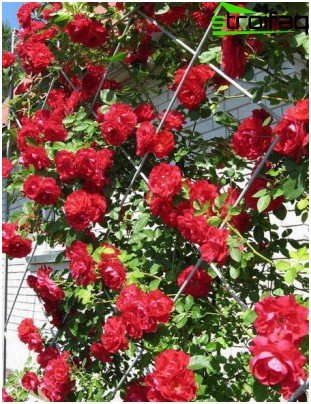
A wicker rose will add charm to any fence, hiding the empty and ugly corners of the plot and attracting attention with its extraordinary flowering.
- For the decoration of arches or arbors, climbing roses related to the type of ramblers are perfect. They will shower a gazebo with a lot of small delicate buds that will delight with their lush flowering and aroma for more than a month and a half. And thanks to the flexible and obedient stems, reaching a length of about 5 meters, you can easily direct plant growth in a given direction. For these purposes, the varieties “Ghistiane de Felidonde”, “Paul Noel”, “Exselsa” are suitable.

The symmetrical arrangement of the arch will look beautiful, but sometimes you can add a twist to the order of things in order to focus attention on some object
Planting bushes
Planting and caring for a climbing rose is not difficult, but requires constant attention. Before choosing a place for a rose, you need to consider that she does not like a draft, shaded areas of the garden and the constantly scorching sun. An ideal place would be where the sun shines directly from early morning, draining dew drops on the leaves of a climbing rose, and partial shade is already formed by noon, protecting delicate buds from the scorching sun. Only then will the bush give many buds and will not stretch unnecessarily.
Important! Almost any soil is suitable for planting, except for wetlands and areas with high underground groundwater. The rose will feel especially good on fertilized slightly acidic or neutral type soils. You should not choose hillocks or a sloping plot of land for these purposes. Only on a flat surface will the rose be comfortable.
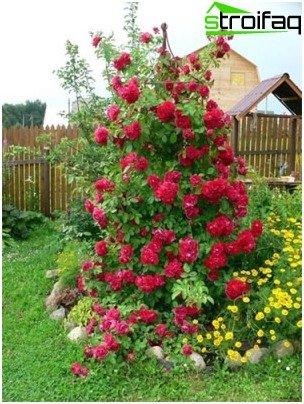
The climbing rose is a perfect screen for various pillars or other problem areas on the site. Having made of it a tall flowerbed in the form of a Christmas tree, you do not have to see dull electric poles or old wells
The ideal time for planting a rose bush would be May and June. It is quite possible to plant it in the fall, although this may be fraught with freezing of a young fragile shoot.
The rose is planted in a pre-fertilized hole with a depth of at least 5 cm. If there is a building wall nearby, it is necessary to maintain a distance of at least half a meter from it and to the hole. The roots of young shoots must be laid in the opposite direction from the wall.
Important! The distance between adjacent holes should be at least 50 cm, but ideally it is best to leave one meter. After planting, the soil is abundantly watered, and then it will be possible to pour a little more earth.
Crown formation
For a beautiful and proper formation of a bush of a climbing rose, support is necessary. For ramblers, the most suitable would be a construction in the form of an arch. Starting from the planting itself, the cuttings will need to be wrapped around the arch as they grow, higher and higher. Thus, in three years, through the flexible branches of the bush, we will reach the earth on the other side of the support, turning it into a beautiful fragrant element of the decor of your garden. But it is much faster to achieve this effect by planting cuttings on both sides. Each fall, the branches are carefully separated, unwinding the support, and carefully laid on the ground, covering with frost by frost.
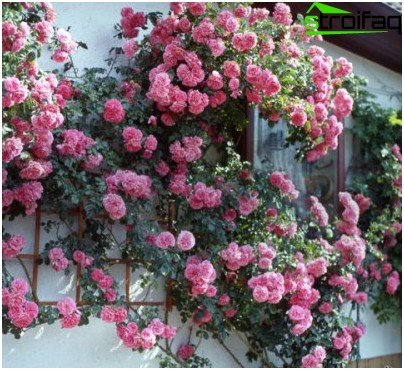
Having let the branches of the rose along the wall of the house, it is necessary to provide support for heavy buds in advance
For Kleimbers, supports in the form of a pyramid or ordinary rusty trash from old wheelbarrows and barrels are suitable. By planting a nearby bush of this plant, you can decorate the site and at the same time hide unsightly junk. Shop supports made of bamboo or plastic will also look good. A good solution will be if this kind of roses is put on the brick wall of the building in the form of a fan. Such a weaving rose does not require special care, only to maintain the shape of the bush you will need to attach several hooks to this wall and fix the branches on them as the rose grows.
Pruning and grooming a climbing rose bush
Given that climbing roses grow very well and grow quickly, pruning is required every year. As necessary, you can make short or medium. An important condition for the proper development of the plant and its rich flowering is the observance of certain pruning rules. So, in the first year of the growth of the bush, you can trim only dried and damaged branches. Short pruning is not needed this year. In the second year of stalk growth, it will be necessary to trim the lateral young shoots, up to a maximum of 4 eyes, and also get rid of dry twigs. In the third year of the development of the bush, an average pruning of shoots is performed, which performs the function of rejuvenating the bush. Thanks to such actions, a climbing rose, the care and pruning of which is carried out correctly and in a timely manner, will be a healthy and beautiful plant.
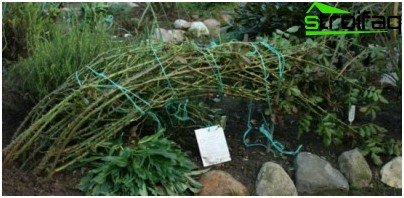
Do not leave rose branches uncovered for the winter. Only with proper wintering will numerous buds appear in the spring, otherwise the rose will freeze
Save the rose from the heat and cold
A wicker rose of any kind requires constant attention. The soil should not dry out, but watering should be moderate. Only during the formation of buds it is slightly increased, and when flowering, they again return to the previous watering regime. Of course, there should be no weeds near the bush. After all, they not only “strangle” the plant and interfere with the development of its root system, but also spoil the appearance of the site. The soil near the climbing rose is periodically loosened and fed with fertilizers (not more than once in ten days).
Important! By the way, if there is a desire to achieve longer flowering, then during this period it is necessary to water the plant with fertilizers containing potassium. It helps to increase the number of buds formed and their longer life.
In late autumn, preferably just before the frost, the branches of the climbing rose are carefully removed from the supports and carefully laid on the ground. Top they are covered with spruce branches to protect against frost. The spruce layer should be about 15 cm thick. Top of the spruce branches is covered with roofing material or roofing felt. The next year, buds are formed only on old shoots that will tolerate winter well and “wake up” in spring.
With the onset of spring, when the average night temperature rises to positive, roofing material is removed, but spruce branches have not yet been touched. They can be removed in a couple of weeks, when the threat of frost passes. It’s also not worth it to delay it, as the hot spring sun will create a greenhouse effect under a layer of spruce branches, and the rose may “burn out” from excessive heat.
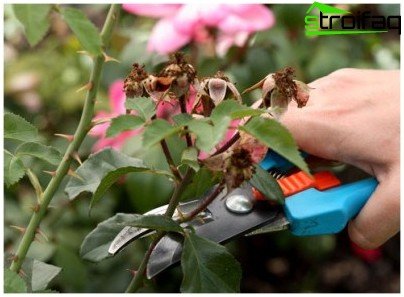
Pruning of roses is carried out in the spring to remove missing and diseased branches. But during the summer, it is also necessary to remove the faded tops, spoiling the appearance of the beauty
The garden plot will be a great vacation spot for its owners, if you take care of the beautiful flowers. Much depends on the layout among plantings of vegetables of bright oases, which will be pleasant to admire both in spring and autumn. The rose is not in vain known as the queen of flowers, and the wicker rightfully won the championship with her unpretentiousness and lush flowering. An increasing variety of its varieties appears in areas. This rose is becoming very popular among gardeners – keep up with you. Then others will admire the garden, and the world around will become more colorful and kinder for everyone. Plant kindness in your garden!






